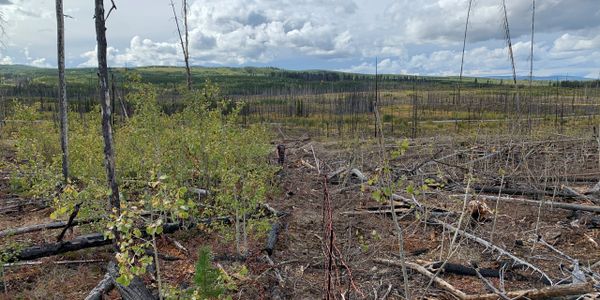Goat Brushing in Forestry
Goats control Vegetation & Deciduous trees
Goats control Vegetation & Deciduous trees
Goats control Vegetation & Deciduous trees

Goats prefer to browse on herbaceous vegetation and deciduous trees, this clears out the lower canopy allowing crop trees to compete during the growing season. Goats will defoliate and girdle deciduous trees like alder, aspen and poplar, sapping the energy from these trees making it harder for them to survive the winter.
Goats Fertilize the Forest Stand
Goats control Vegetation & Deciduous trees
Goats control Vegetation & Deciduous trees

Fertilization is a recognized Forest Carbon Initiative activity that will increase carbon sequestration and tree performance. Goats brush and fertilize at the same time; biologically processing hazardous vegetation back into the soil. This increases soil biomass (carbon) and biological activity to make the landscape more resilient and productive.
Goats reduce fire hazard with kinetic energy
Goats dimple the landscape and improve water retention
Goats dimple the landscape and improve water retention

Finally the goats are delivering a tremendous amount of renewable, kinetic energy to forest floor, our 190 goats (12 000+lbs) are constantly trampling and degrading dry surface fuels, which reduce the fire hazard and speed their decomposition back into the soil.
Goats dimple the landscape and improve water retention
Goats dimple the landscape and improve water retention
Goats dimple the landscape and improve water retention

Goats cover the landscape, on hills and slopes with millions of little hoof prints that create a dimpling effect. When it rains water is trapped in these little pools and is less able to "Run-off". This dimpling effect improves the ability of the soil to retain water.
2020 Year in Review
Utilizing Goat Brushing to achieve Free to Grow Status

BC Timber Goats
In 2020 BC Timber Goats completed a contract targeting deciduous species like aspen, alder and poplar for Pacific BioEnergy, in the Bobtail Forest Area. Click the link below to check out our project on CKPG!
LIvestock and Biochar in Forest Management

A forest company in British Columbia can benefit from adopting livestock grazing and biochar in their forest management practices in several ways:
- Vegetation Management: Livestock grazing can help control understory vegetation and reduce the risk of forest fires. Grazing animals, such as goats or sheep, can selectively consume grasses, shrubs, and small trees, which helps maintain open spaces, reduce fuel loads, and mitigate the spread of wildfires. This can be particularly beneficial in areas where manual or mechanical vegetation management is challenging or expensive.
- Cost Savings: Adopting livestock grazing as a vegetation management tool can potentially lead to cost savings for the forest company. Grazing animals can help reduce the need for costly manual or mechanical vegetation control methods. This can include reducing the need for mowing, herbicide application, or mechanical clearing. Implementing livestock grazing as a sustainable and cost-effective alternative can positively impact the company's bottom line.
- Improved Forest Health: Livestock grazing can contribute to improved forest health by reducing the competition from invasive plant species. Grazing animals can selectively consume invasive plants, helping to control their spread and prevent them from outcompeting native vegetation. This promotes the regeneration and growth of desired tree species, leading to healthier and more resilient forest ecosystems.
- Soil Fertility and Nutrient Cycling: Livestock grazing can enhance soil fertility and nutrient cycling in forested areas. Animal manure contains valuable nutrients that are deposited onto the forest floor, enriching the soil and providing essential elements for plant growth. Improved soil fertility can promote healthier tree growth and contribute to overall ecosystem productivity.
- Carbon Sequestration and Biochar Production: Integrating biochar production into forest management practices offers an additional benefit. Biochar is a stable form of carbon that can be produced from forest biomass or livestock waste. By converting forest biomass into biochar through pyrolysis, the forest company can sequester carbon in a long-term stable form. This can help offset greenhouse gas emissions and contribute to climate change mitigation efforts. Additionally, biochar can be used as a soil amendment to enhance soil fertility, water retention, and nutrient availability, further supporting forest ecosystem health and productivity.
- Diversification and Value-Added Products: Adopting livestock grazing and biochar production can allow the forest company to diversify its product offerings and explore value-added opportunities. The company can potentially sell livestock products, such as meat or wool, in addition to traditional timber products. Furthermore, the production and sale of biochar can open new revenue streams and market opportunities, especially in sectors that prioritize sustainable and carbon-neutral products.
It is important for the forest company to assess the feasibility, environmental impacts, and regulatory requirements associated with livestock grazing and biochar production. Collaboration with livestock farmers, biochar producers, and relevant stakeholders can provide valuable insights and help navigate the integration of these practices into forest management. Proper planning, monitoring, and adaptive management approaches are necessary to ensure that the adoption of livestock grazing and biochar aligns with sustainable forest management objectives and contributes to the overall ecological health of the forest ecosystem.
BC Timber Goats respectfully acknowledges it is located on the unceded traditional territory of Wei Wai Kum Kwiakah and K'ómoks First Nation First Nations.
Copyright © 2018 BC Timber Goats - Contact 250-203-3534 -All Rights Reserved.
Powered by GoDaddy
This website uses cookies.
We use cookies to analyze website traffic and optimize your website experience. By accepting our use of cookies, your data will be aggregated with all other user data.